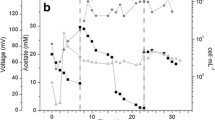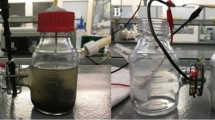Abstract
Instead of the utilization of artificial redox mediators or other catalysts, a biocathode has been applied in a two-chamber microbial fuel cell in this study, and the cell performance and microbial community were analyzed. After a 2-month startup, the microorganisms of each compartment in microbial fuel cell were well developed, and the output of microbial fuel cell increased and became stable gradually, in terms of electricity generation. At 20 ml/min flow rate of the cathodic influent, the maximum power density reached 19.53 W/m3, while the corresponding current and cell voltage were 15.36 mA and 223 mV at an external resistor of 14.9 Ω, respectively. With the development of microorganisms in both compartments, the internal resistance decreased from initial 40.2 to 14.0 Ω, too. Microbial community analysis demonstrated that five major groups of the clones were categorized among those 26 clone types derived from the cathode microorganisms. Betaproteobacteria was the most abundant division with 50.0% (37 of 74) of the sequenced clones in the cathode compartment, followed by 21.6% (16 of 74) Bacteroidetes, 9.5% (7 of 74) Alphaproteobacteria, 8.1% (6 of 74) Chlorobi, 4.1% (3 of 74) Deltaproteobacteria, 4.1% (3 of 74) Actinobacteria, and 2.6% (2 of 74) Gammaproteobacteria.







Similar content being viewed by others
References
An YJ, Joo YH, Hong IY, Ryu HW (2004) Microbial characterization of toluene-degrading denitrifying consortia obtained from terrestrial and marine ecosystems. Appl Microbiol Biot 65:611–619
Angenent LT, Karim K, Al-Dahhan MH, Wrenn BA, Domiguez-Espinosa R (2004) Production of bioenergy and biochemicals from industrial and agricultural wastewater. Trends Biotechnol 22:477–485
Barak Y, Tal Y, van Rijn J (1998) Light-mediated nitrite accumulation during denitrification by Pseudomonas sp. strain JR12. Appl Environ Microbiol 64:813–817
Bard AJ, Faulkner LR (2001) Electrochemical method: fundamentals and applications, 2nd edn. Wiley, New York
Bergel A, Feron D, Mollica A (2005) Catalysis of oxygen reduction in PEM fuel cell by seawater biofilm. Electrochem Commun 7:900–904
Biffinger JC, Ray R, Little B, Ringeisen BR (2007) Diversifying biological fuel cell designs by use of nanoporous filters. Eviron Sci Technol 41:1444–1449
Bond DR, Lovley DR (2003) Electricity production by Geobacter sulfurreducens attached to electrodes. Appl Environ Microbiol 69:1548–1555
Bullen RA, Arnot TC, Lakeman JB, Walsh FC (2006) Biofuel cells and their development. Biosens Bioelectron 21:2015–2045
Cheng S, Liu H, Logan BE (2006) Power densities using different cathode catalysts (Pt and CoTMPP) and polymer binders (Nafion and PTFE) in single chamber microbial fuel cells. Eviron Sci Technol 40:364–369
Clauwaert P, Rabaey K, Aelterman P, De Schamphelaire L, Pham TH, Boeckx P, Boon N, Verstraete W (2007a) Biological denitrification in microbial fuel cells. Eviron Sci Technol 41:3354–3360
Clauwaert P, Van der Ha D, Boon N, Verbeken K, Verhaege M, Rabaey K, Verstraete W (2007b) Open air biocathode enables effective electricity generation with microbial fuel cells. Eviron Sci Technol 41:7564–7569
Du ZW, Li HR, Gu TY (2007) A state of the art review on microbial fuel cells: a promising technology for wastewater treatment and bioenergy. Biotechnol Adv 25:464–482
Dunstan RH, Kelley BC, Nicholas DJ (1982) Fixation of dinitrogen derived from denitrification of nitrate in a photosynthetic bacterium, Rhodopseudomonas sphaeroides forma sp. denitrificans. J Bacteriol 150:100–104
Eisentraeger A, Klag P, Vansbotter B, Heymann E, Dott W (2001) Denitrification of groundwater with methane as sole hydrogen donor. Water Res 35(9):2261–2267
Elmore BO, Bergmann DJ, Klotz MG, Hooper AB (2007) Cytochromes P460 and c’-beta; a new family of high-spin cytochromes c. Febs Lett 581:911–916
Felsenstein J (1985) Confidence limits on phylogenies: an approach using the bootstrap. Evolution 39:783–791
Freguia S, Rabaey K, Yuan Z, Keller J (2007) Non-catalyzed cathodic oxygen reduction at graphite granules in microbial fuel cells. Electrochimi Acta 53:598–603
Gil GC, Chang IS, Kim BH, Kim M, Jang JK, Park HS, Kim HJ (2003) Operational parameters affecting the performance of a mediator-less microbial fuel cell. Biosens Bioelectron 1:8:327–334
Gralnick JA, Newman DK (2007) Extracellular respiration. Mol Microbiol 65:1–11
Grzebyk M, Pozniak G (2005) Microbial fuel cells (MFCs) with interpolymer cation exchange membranes. Sep Purif Technol 41:321–328
He Z, Angenent LT (2006) Application of bacterial biocathodes in microbial fuel cells. Electronal 18:2009–2015
Hedgecock LW, Costello RL (1962) Utilization of nitrate by pathogenic and saprophytic Mycobacteria. J Bacteriol 84:195–205
Heylen K, Vanparys B, Wittebolle L, Verstraete W, Boon N, De Vos P (2006) Cultivation of Denitrifying Bacteria: Optimization of Isolation Conditions and Diversity Study. Appl Environ Microbiol 72:2637–2643
Jorgensen KS, Pauli ASL (1995) Polyphosphate accumulation among denitrifying bacteria in activated sludge. Anaerobe 1:161–168
Kargi F, Eker S (2007) Electricity generation with simultaneous wastewater treatment by a microbial fuel cell (MFC) with Cu and Cu-Au electrodes. J Chem Technol Biot 82:658–662
Kim BH, Chang IS, Gadd GM (2007a) Challenges in microbial fuel cell development and operation. Appl Microbiol Biot 76:485–494
Kim JR, Cheng S, Oh SE, Logan BE (2007b) Power generation using different cation, anion, and ultrafiltration membranes in microbial fuel cells. Eviron Sci Technol 41:1004–1009
Koenig A, Zhang T, Liu LH, Fang HHP (2005) Microbial community and biochemistry process in auto sulfurotrophic denitrifying biofilm. Chemosphere 58:1041–1047
Labbe N, Juteau P, Parent S, Villemur R (2003) Bacterial diversity in a marine methanol-fed denitrification reactor at the Montreal biodome, Canada. Microb Ecol 46:12–21
Lee HW, Lee SY, Lee JO, Kim HG, Park JB, Choi E, Park YK (2003) The microbial community analysis of a 5-stage BNR process with step feed system. Water Sci Technol 48:135–141
Liu H, Ramnarayanan R Logan BE (2004) Production of electricity during wastewater treatment using a single chamber microbial fuel cell. Eviron Sci Technol 38:2281–2285
Logan BE (2004) Extracting hydrogen electricity from renewable resources. Eviron Sci Technol 38:160A–167A
Logan BE, Hamelers B, Rozendal R, Schroder U, Keller J, Freguia S, Aelterman P, Verstraete W, Rabaey K (2006) Microbial fuel cells: methodology and technology. Eviron Sci Technol 40:5181–5192
Logan B, Cheng S, Watson V, Estadt G (2007) Graphite fiber brush anodes for increased power production in air-cathode microbial fuel cells. Eviron Sci Technol 41:3341–3346
Ohta H, Hattori R, Ushiba Y, Mitsui H, Ito M, Watanabe H, Tonosaki A, Hattori T (2004) Sphingomonas oligophenolica sp. nov., a halo- and organo-sensitive oligotrophic bacterium from paddy soil that degrades phenolic acids at low concentrations. Int J Syst Evol Micr 54:2185–2190
Park HI, Mushtaq U, Perello D, Lee I, Cho SK, Star A, Yun M (2007) Effective and low-cost platinum electrodes for microbial fuel cells deposited by electron beam evaporation. Energ Fuel 21:2984–2990
Rabaey K, Verstraete W (2005) Microbial fuel cells: novel biotechnology for energy generation. Trends Biotechnol 23:291–298
Rabaey K, Boon N, Siciliano SD, Verhaege M, Verstraete W (2004) Biofuel cells select for microbial consortia that self-mediate electron transfer. Appl Environ Microbiol 70:5373–5382
Rabaey K, Clauwaert P, Aelterman P, Verstraete W (2005a) Tubular microbial fuel cells for efficient electricity generation. Eviron Sci Technol 39:8077–8082
Rabaey K, Ossieur W, Verhaege M, Verstraete W (2005b) Continuous microbial fuel cells convert carbohydrates to electricity. Water Sci Technol 52:515–523
Rittmann BE (2006) Microbial ecology to manage processes in environmental biotechnology. Trends Biotechnol 24(6):261–266
Rosenbaum M, Zhao F, Schroder U, Scholz F (2006) Interfacing electrocatalysis and biocatalysis with tungsten carbide: a high-performance, noble-metal-free microbial fuel cell. Angew Chen Int Edit 45:6658–6661
Saitou N, Nei M (1987) The neighbor-joining method: A new method for reconstructing phylogenetic trees. Mol Biol Evol 4:406–425
Schroder U (2007) Anodic electron transfer mechanisms in microbial fuel cells and their energy efficiency. Phys Chem Chem Phys 9:2619–2629
Takeuchi M, Hamana K, Hiraishi A (2001) Proposal of the genus Sphingomonas sensu stricto and three new genera, Sphingobium, Novosphingobium and Sphingopyxis, on the basis of phylogenetic and chemotaxonomic analyses. Int J Syst Evol Micr 51:1405–1417
Tamura K, Nei M, Kumar S (2004) Prospects for inferring very large phylogenies by using the neighbor-joining method. Proc Natl Acad Sci U S A 101:11030–11035
Tamura K, Dudley J, Nei M, Kumar S (2007) MEGA4: Molecular Evolutionary Genetics Analysis (MEGA) software version 4.0. Mol Biol Evol 24(8):1596–1599
Tan ZY, Reinhold-Hurek B (2003) Dechlorosoma suillum Achenbach et al. 2001 is a later subjective synonym of Azospira oryzae Reinhold-Hurek and Hurek 2000. Int J Syst Evol Micr 53:1139–1142
Tender LM, Reimers CE, Stecher HA, Holmes DE, Bond DR Lowy DA, Pilobello K, Fertig SJ, Lovely DR (2002) Harnessing microbially generated power on the seafloor. Nat Biotechnol 20:821–825
Terheijne A, Hamelers HVM, De Wilde V, Rozendal RA, Buisman CJN (2006) A bipolar membrane combined with ferric iron reduction as an efficient cathode system in microbial fuel cells. Eviron Sci Technol 40:5200–5205
Yoshie S, Ogawa T, Makino H, Hirosawa H, Tsuneda S, Hirata A (2006) Characteristics of bacteria showing high denitrification activity in saline wastewater. Lett Appl Microbiol 42:277–283
Zhao F, Harnisch F, Schrorder U, Scholz F, Bogdanoff P, Herrmann I (2005) Application of pyrolysed iron(II) phthalocyanine and CoTMPP based oxygen reduction catalysts as cathode materials in microbial fuel cells. Electrochem Commun 7:1405–1410
Zhao F, Harnisch F, Schrorder U, Scholz F, Bogdanoff P, Herrmann I (2006) Challenges and constraints of using oxygen cathodes in microbial fuel cells. Eviron Sci Technol 40:5193–5199
Acknowledgment
The authors would like to thank Dr. K. Rabaey, Dr. Z. Yuan and Dr. J. Keller (University of Queensland, Australia) for providing the MFC reactors and the helpful comments. This research was supported by the Second stage of Brain Korea 21 Project in 2007.
Author information
Authors and Affiliations
Corresponding author
Rights and permissions
About this article
Cite this article
Chen, GW., Choi, SJ., Lee, TH. et al. Application of biocathode in microbial fuel cells: cell performance and microbial community. Appl Microbiol Biotechnol 79, 379–388 (2008). https://doi.org/10.1007/s00253-008-1451-0
Received:
Revised:
Accepted:
Published:
Issue Date:
DOI: https://doi.org/10.1007/s00253-008-1451-0




